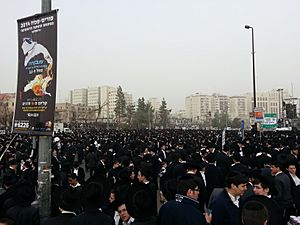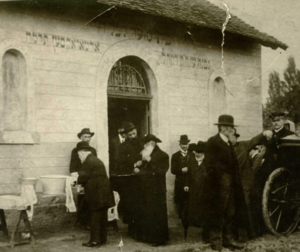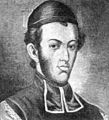Orthodox Judaism facts for kids
| Part of a series on | |||
|---|---|---|---|
|
|||
| Judaism | |||
| Category | |||
| Jewish religious movements | |||
| Orthodox (Haredi • Hasidic • Modern) | |||
| Conservative • Reform | |||
| Reconstructionist • Renewal • Humanistic | |||
| Jewish philosophy | |||
| Principles of faith • Kabbalah • Messiah • Ethics | |||
| Chosenness • Names of God • Musar | |||
| Religious texts | |||
| Tanakh (Torah • Nevi'im • Ketuvim) | |||
| Ḥumash • Siddur • Piyutim • Zohar | |||
| Rabbinic literature (Talmud • Midrash • Tosefta) | |||
| Religious Law | |||
| Mishneh Torah • Tur | |||
| Shulchan Aruch • Mishnah Berurah | |||
| Kashrut • Tzniut • Tzedakah • Niddah • Noahide laws | |||
| Holy cities | |||
| Jerusalem • Safed • Hebron • Tiberias | |||
| Important figures | |||
| Abraham • Isaac • Jacob | |||
| Moses • Aaron • David • Solomon | |||
| Sarah • Rebecca • Rachel • Leah | |||
| Rabbinic sages | |||
| Jewish life cycle | |||
| Brit • Pidyon haben • Bar/Bat Mitzvah | |||
| Marriage • Bereavement | |||
| Religious roles | |||
| Rabbi • Rebbe • Posek • Hazzan/Cantor | |||
| Dayan • Rosh yeshiva • Mohel • Kohen/Priest | |||
| Religious buildings & institutions | |||
| Synagogue • Beth midrash • Mikveh | |||
| Sukkah • Chevra kadisha | |||
| Holy Temple / Tabernacle | |||
| Jewish education | |||
| Yeshiva • Kollel • Cheder | |||
| Religious articles | |||
| Sefer Torah • Tallit • Tefillin • Tzitzit • Kippah | |||
| Mezuzah • Hanukiah/Menorah • Shofar | |||
| 4 Species • Kittel • Gartel | |||
| Jewish prayers and services | |||
| Shema • Amidah • Aleinu • Kaddish • Minyan | |||
| Birkat Hamazon • Shehecheyanu • Hallel | |||
| Havdalah • Tachanun • Kol Nidre • Selichot | |||
| Judaism & other religions | |||
| Christianity • Islam • Judeo-Christian | |||
| Abrahamic faiths | |||
| Related topics | |||
| Antisemitism • The Holocaust • Israel • Zionism | |||
Orthodox Judaism is a branch of Judaism that follows traditional Jewish laws and beliefs very closely. Orthodox Jews believe that the Torah (which includes both the Written and Oral Torah) was given by God to Moses on Mount Sinai. They believe these teachings have been passed down faithfully through many generations.
Orthodox Jews follow halakha, which is traditional Jewish law. Some key practices include:
They also believe in a future Messiah. This Messiah will bring all Jews back to Israel and rebuild the Third Temple in Jerusalem. Orthodox Jews also believe that people will be brought back to life after death. They believe good deeds will be rewarded, and bad deeds will be punished.
Orthodox Judaism has two main groups. Haredi Judaism is more traditional and often keeps to itself. Modern Orthodox Judaism is more open to modern society. Both groups see their way of life as the true form of Judaism.
Contents
Daily Life for Orthodox Jews
Orthodox Jews follow many rules in their daily lives. These include rules about kosher food, the Shabbat (Sabbath), and family purity. They also have daily prayers called tefilah.
You can often recognize Orthodox Jews by their clothing. Both men and women dress modestly, covering most of their skin. Married women usually cover their hair. They might use scarves (tichel), snoods, turbans, hats, or wigs.
Orthodox men usually wear a special fringed garment called Tzitzit. They also wear a head-covering, like a kippah, at all times. Many Orthodox men grow beards. Haredi men often wear black hats and suits. Modern Orthodox Jews might dress more like others in society. However, they still wear kippahs and tzitzit. On Shabbat, Modern Orthodox men wear suits or dress shirts. Women wear fancier dresses or blouses.
Orthodox Jews also follow the laws of negiah. This means "touch." Orthodox men and women do not touch people of the opposite sex. This rule applies unless they are married to them or are close family members. Close family includes parents, grandparents, siblings, children, and grandchildren. Kol Isha is another rule. It means a man should not listen to a woman's singing voice.
Many Orthodox homes have a mezuzah on their doorposts. It is also common to see separate sinks for meat and dairy foods in their kitchens.
Main Groups in Orthodox Judaism
Orthodox Judaism includes several different groups. Each group has its own customs and ways of life.
Understanding Haredi Jews

The Haredim are a well-known group. Their name means "trembling" or "fervent." They are also called "strictly Orthodox." Haredim usually have little involvement with modern society and culture. Some Haredim do not approve of more modern Orthodox groups. You can often spot them by their clothing. Men often wear all black, and women dress very modestly. This includes covering their hair and wearing long skirts.
The Haredi community is very diverse. It includes many different communities. They can be divided into three main sub-groups.
Hasidic Jews
The first Haredi sub-group is the Hasidic Jews. This group started in Eastern Europe in the 1700s. Each Hasidic community has a leader called a rebbe. The rebbe is almost always a rabbi. Rebbes guide the lives of their followers very closely.
There are hundreds of independent Hasidic groups. Each group has its own rebbe and unique customs. They also have their own beliefs and styles of dress. Hasidic men, especially on the Sabbath, wear long coats and fur hats. These were once common for all Eastern European Jews. As of 2016, there were 130,000 Hasidic households worldwide.
Litvaks (Yeshivish)
The second Haredi group is called the "Litvaks" or "Yeshivish." This group is defined by their connection to yeshivas. A yeshiva is a Jewish school for religious study. The "Litvak" group is mainly led by the heads of these yeshivas.
Sephardic Haredim
The third ultra-Orthodox group is the Sephardic Haredim. These Jews live in very observant communities. However, unlike the Hasidim or Litvaks, they keep strong ties with the non-Haredi Mizrahi society in Israel.
Images for kids
-
Young Samson Raphael Hirsch, who promoted Orthodox separation in Germany.
-
Haredi schoolgirls at the Western Wall.
See also
 In Spanish: Judaísmo ortodoxo para niños
In Spanish: Judaísmo ortodoxo para niños












